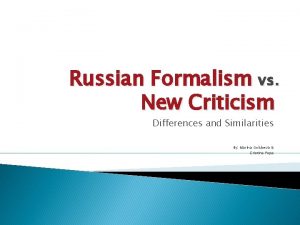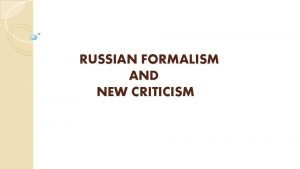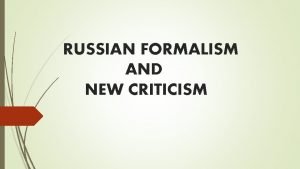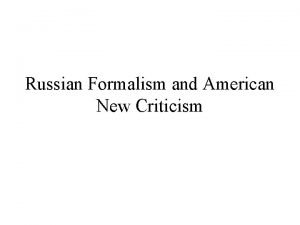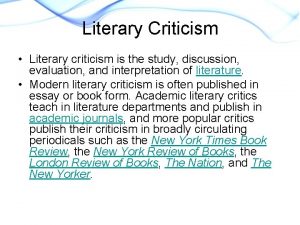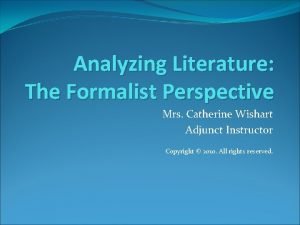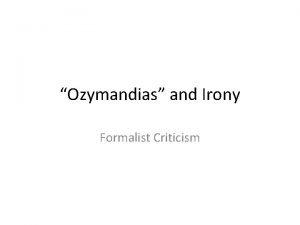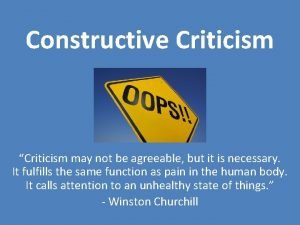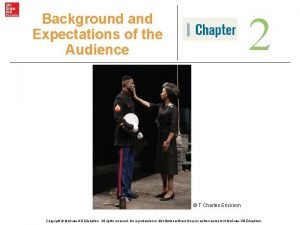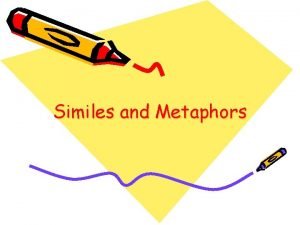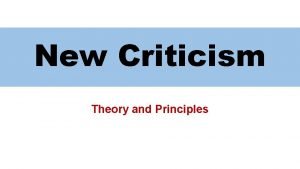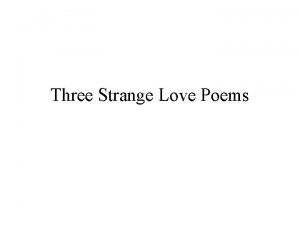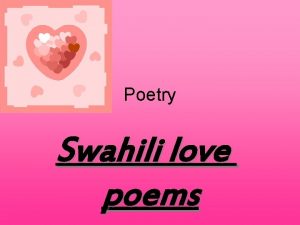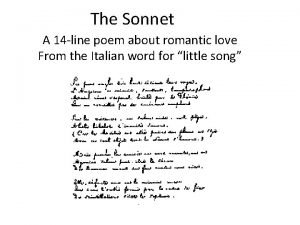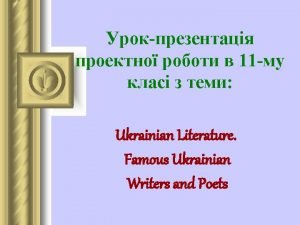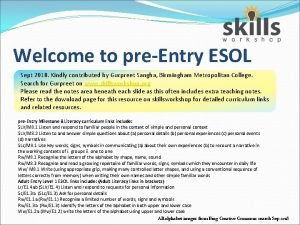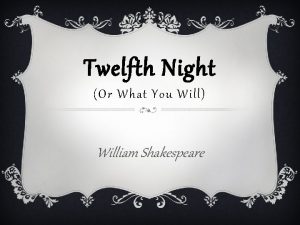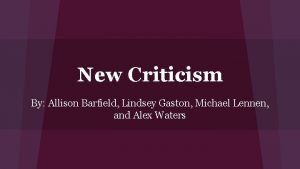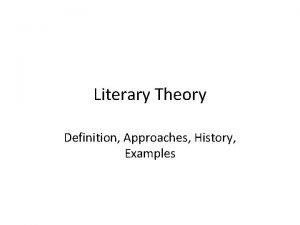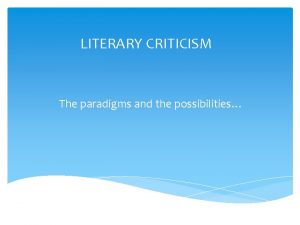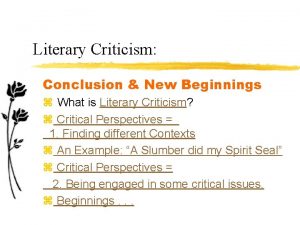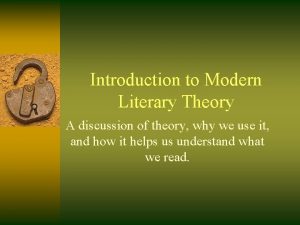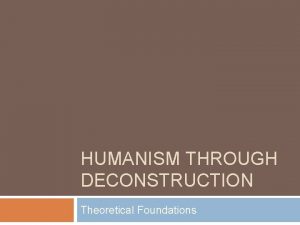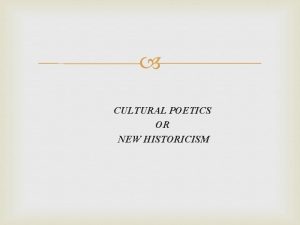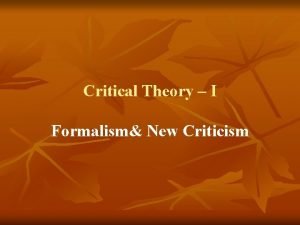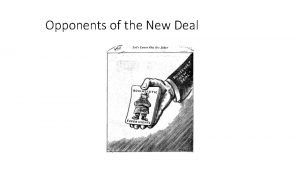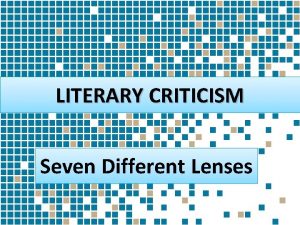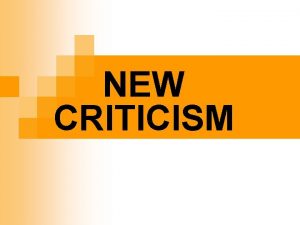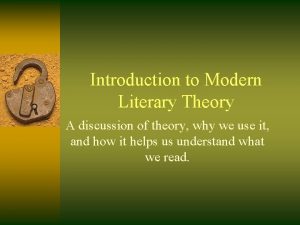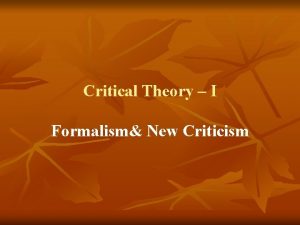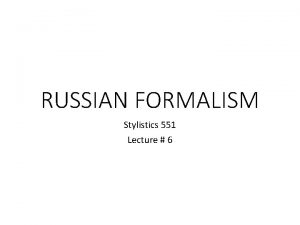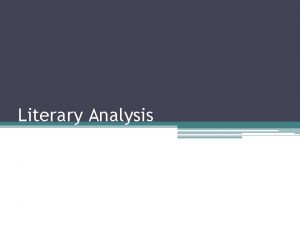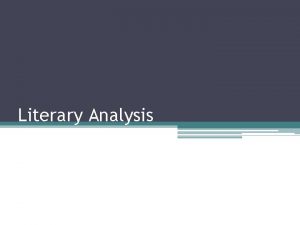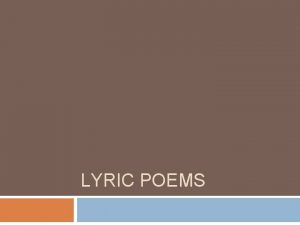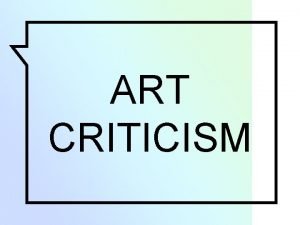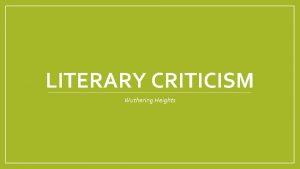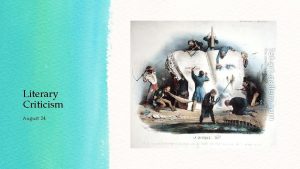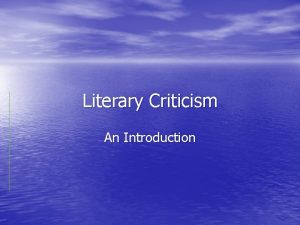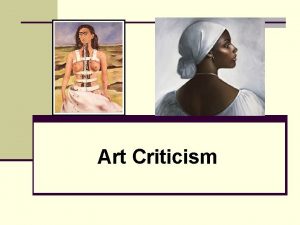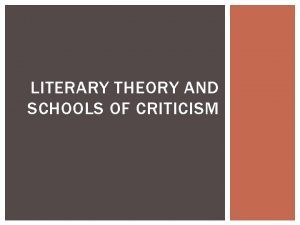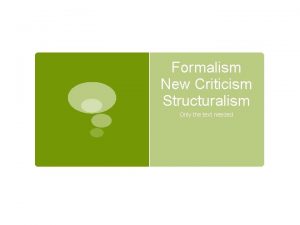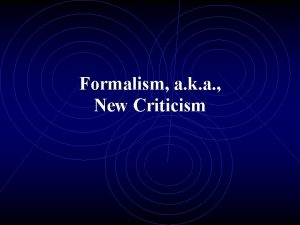Formalism New Criticism Some More Love Poems and

















































- Slides: 49

Formalism (New Criticism) & Some More Love Poems and Stories

Central Questions Liberal Humanism Traditional Approaches Can anything “human” transcend time and space (be eternal and universal) for you? (Love, masterpieces, maternal love, friendship, humanity? ) Are we ultimately free? Is our subjectivity unified or fragmentary? What is culture/literature? How is it related to our daily life? Can we resist commercial culture through cultivating our “artistic” sensibility? Do you feel nostalgic about “a certain historical period”? What are the values in reading literature? Is it the finest example of culture? How do we read a poem/text? What do we look for? The author’s ideas? How they reflect his/her life or the social-historical movements? How we

Outline New Criticism: Key Words Theoretic Basis: Literature as a profession; a Religion and the only solution to worldly chaos. – Matthew Arnold: Culture vs. Anarchy – Organic Whole & (T. S. Eliot) Objective Correlative New Criticism: major assumptions & methods Romantic story and Victorian love poems in the context from idealism & of the Victorian vs. repression to disunity and franker views of the Modern Views of Love Reference and Assignments body and desire)

Key Words New Criticism defined 33 Ideals of New Criticism: 1. Autonomy (34) & Liberal Humanism 2. Organic unity 33 3. Component (1): Objective Correlative (Eliot) (chap 2 33) 4. Component (2): Paradox, irony, ambiguity and tension Against: Intentional Fallacy; Affective Fallacy; Heresy of Paraphrase (New Critics) (40) See also p. 43

Theoretical Basis (1) M. Arnold: Culture vs. Anarchy Culture: – “the best that has been thought and said” – universal and timeless – Involves intellectual refinement and sensibility, disinterested pursuit of goodness, spiritual activity e. g. Hellenism: Greek culture e. g. Poetry— Bertens 2 -5 Anarchy: caused by capitalism and middle-class Protestantism. Philistinism: selfcentered, materialistic – note: Philistine--(昔) 巴勒斯坦西南岸之居 民,庸俗的人

Arnold (2): Art’s Timelessness & Liberal Humanism The “ultimate” autonomy and self-sufficiency of the subject (Bertens 6) we are essentially free. Likewise, literature, or its universal values, is not constrained by its time and space. Still relevant today: – e. g. “Isn’t it true that many of us, at least at some point in our life, want to see literature as a highminded enterprise by and for sensitive and finetuned intellectuals that is somehow several steps removed from the trivial push and pull or ordinary life? ” – 與古人心靈交會 – We choose to be who we are today and we will be

Theoretical Basis (2) Textual Autonomy = Organic Unity the poet‘s mind as a catalyst (觸媒) Experience CO 2+葉綠素 光合作用 objective correlatives (33) Organic whole

New Criticism: Major Assumption (2) – organic wholeness organic unity: (33) – all of its elements (form and content, poetic elements, tensions) form a “single unified effect. ” – all parts of a poem are interrelated and interconnected, with each part reflecting and helping to support the poem's central idea. . allows for the harmonization of conflicting ideas, feelings, and attitudes, . . .

objective correlative 客觀對應物 (T. S. Eliot) An external object used to convey the writer’s feeling, which is elevated to a universal level in writing so that the same feelings can be evoked in the reader. “The only way of expressing emotion in the form of art is by finding an ‘objective correlative’; in other words, a set of objects, a situation, a chain of events which shall be the formula of that particular emotion; such that when the external facts, which must terminate in sensory experience, are given, the emotion is

objective correlative: e. g. 客觀對應物 (T. S. Eliot) e. g. Images of coldness in Hardy’s “Neutral Tones” e. g. “. . . the sun was white, as though chidden of God ” “The Love Song of J. Alfred Prufrock” “Let us go then, you and I, When the evening is spread out against the sky Like a patient etherized(乙醚麻醉) upon a table” In a Station of the Metro THE apparition of these faces in the crowd; Petals on a wet, black bough.

T. S. Eliot: his Value Judgment dislikes PERCY BYSSHE SHELLEY and Tennyson—too emotional for him. e. g. “Oh, lift me as a wave, a leaf, a cloud! I fall upon the thorns of life! I bleed!” (ODE TO THE WEST WIND ) Favors “metaphysical poetry, ” which unites emotions and wits. What comes after 17 th century poetry is a dissociation of sensibility. finds ‘organic unity’ in literature

New Criticism: Major Assumptions (Bertens 21 -23 ) A poem is an autonomy (獨立個體), its meanings decided by itself alone, but not by the author’s intention or the reader’s emotional responses to it. Intentional Fallacy (意圖謬誤 40), Affective Fallacy (感情謬誤) Poetry offers a different kind of truth (poetic truth) than science, conveyed through its dense language which cannot be translated. Heresy of Paraphrase

New Criticism: Methodology New Criticism’s synonyms = objective criticism, practical criticism, textual criticism, close reading the "text and the text alone" approach

New Criticism on Poetry (chap 2 34 -42; Bressler 44 - 45) 1. Pay close attention to the text’s diction: its meanings (connotation and denotation) and even its etymological roots. a. Its figurative language 比喻語言(明喻、暗喻、擬人法、 頓呼法) 2. Study its form or pattern; e. g. a. Traditional or free or open form b. Sound pattern (prosody詩律); Image Pattern, Symbolic structure, elaborate conceit p. 39 c. structure and patterns; e. g. oppositions in the text (paradox, ambiguity, irony p. 39) 3. In other words, do a close reading of all the poetic/narrative elements and try to find out it unifying meaning (from Parts to an Organic

New Criticism: Methodology (1) Poetry Parts Diction (Denotations, connotations & etymological roots) Allusions Prosody Relationships among the various elements Whole Themes Pattern; tension ambiguities, paradox, contradictions

New Criticism: Methodology (1) Narrative Parts Point of view, dialogue, setting, Plot Characterization Relationships among the various elements Whole Themes pattern, tension, ambiguities, paradox, contradictions

Romantic/Victorian love stories in the context of the Victorian vs. Modern Views of Love • “The Trial of Love” • Mary Shelley • Sonnets 26 and 43 • EBB: her Life and her Marriage • Paintings: female and male desire and end of love

“The Trial of Love”— Questions (1) How do you divide the story into the beginning, middle and end? And where are the turning points? What do you think about the story and the different moments of choice? the choices – of love by Angeline and Ippolito – of the vow of silence and separation for one year – of love for Faustina (A’s) – of not breaking the vow when meeting the lover – of writing the letter for Faustina (A’s)

“The Trial of Love”—Plot and Turning Points Beginning: background + section (1) A leaves the convent to go see F(*of A’s love for Faustina) two possibilities for a near future flashback (* of love between Angeline and Ippolito; of the vow of silence and separation for one year) section (2) A goes back to the convent, meeting I on the road (*of not breaking the vow when meeting the lover) Middle: section (3) F goes to visit A and goes back with A section (4) frightened by a buffalo, rescued by I I injured; F’s story (of being rescued by her cavalier); A’s action and repression (p. 16) section (5) I recovers and join F in the saloon, A refrains from visiting them section (6) F’s invitation becomes more urgent A. feel uncertain visits the villa without seeing I *writing the letter for Faustina Climax and Denouement/Ending: section (7) A goes to

“The Trial of Love”—Questions for Pattern Character Relationship: How is Angeline contrasted with Faustina in their personalities and backgrounds? How about Ippolito? (e. g. 12, pp. 15 -16) In what ways is Angeline a typical 19 th century angel? Is she just an angel? What role does she take? Structure and Plot: Where do you start to see ironies? After the turning point aren’t the characters weaving stories (or lies) about their experience? Whose stories follow the pattern (or ideologies) of Romantic love? Language: As a 19 th-century story, the descriptions of personal emotions are mostly external (that of eyes, lips, etc. ) Do you find any images typically Romantic? (e. g. 10)

Trial of Love: Manifold Ironies Thesis: The story presents Romantic but inconstant love ironically, while the final irony is on the heroine (or the author) who still believes in love’s eternity. A. Romantic love criticized: -- Faustina’s egotism and her stereotypical story 15, 16. -- A also has her romantic idea (16) -- All rush into love; only the man gets a chance to be inconstant, and the woman gets a “cavalier servant” (22). B. Situational ironies –who is blind?

Trial of Love: Ironies on Angeline A typical self-sacrificing angel who represses herself unsuccessfully and could not always sacrifice herself: – takes the role of a mother (to replace her mother) – thinks she writes the letter for F, but actually for herself (19) – Despite her repression, she cannot help having feelings and desire -- mixture of feelings (pp. 13, when meeting I on the road); vent her grief onto I’s father – cries on her way to the saloon; keeping a false hope even when receiving the letter.

“The Trial of Love” in Context A story less successful than Frankenstein? – Shelley contributed it to The Keepsake for 1835, after she becomes a widow neglected by her friends and Percy Shelley's relations, with a young son to feed, clothe, and house. – The Keepsake: enormously popular with the buying public but just as widely reviled in precisely the literary circles to which Shelley by rights belonged – In practical terms, the Keepsake writer's assignment is to produce an interesting, compact narrative that provides some degree of intersection with the subject of the engraving, which was usually chosen by the editors before the tale had been commissioned. (O'Dea)

“The Trial of Love” in Context (2) The engraving: a “light-haired woman points vaguely both to [a letter on the floor] and to the dark-haired woman”; a man’s hat and cloak on the table. The story Shelley fleshes out suggests the complexity of Angeline’s feelings. The missing ‘mother’ –in Frankenstein as well as in this story.

EBB’s sonnets: Questions What are the main ideas of Sonnet 26 and 43? Are they “good” poems from the standard of New Criticism? What do you think about EBB’s modes of love? Note: sonnet forms – English (Shakespearean) sonnet: Quartrain (abab cdcd efef) couplet (gg) – Italian (Petrarchan): Octave (abba )

Sonnet forms Italian: two parts -- "The octave bears the burden; a doubt, a problem, a reflection, a query, an historical statement, a cry of indignation or desire, a Vision of the ideal. The sestet eases the load, resolves the problem or doubt, answers the query, solaces the yearning, realizes the vision. “ English: the final couplet -- a commentary on the foregoing, an

Sonnet 26 I lived with visions for my company Instead of men and women, years ago, And found them gentle mates, nor thought to know A sweeter music than they played to me. But soon their trailing purple was not free Of this world's dust, their lutes did silent grow, And I myself grew faint and blind below Their vanishing eyes. Then THOU didst come—to be, Beloved, what they seemed. Their shining fronts, Their songs, their splendors (better, yet the same, As river-water hallowed into fonts聖水盆 ), Met in thee, and from out thee overcame My soul with satisfaction of all wants: Because God's gifts put man's best dreams to shame.

Sonnet 26: More Questions What pattern(s) can you find from this sonnet? Is it an Italian sonnet or Shakespearean sonnet? How does the sonnet form help convey the idea? (Where do you find the break? ) What about the other poetic techniques such as the use of metaphor, repetition (“thee”) and punctuation? How about the ending: what does “man”

Sonnet 26 (1) Thesis: 1. The speaker expresses the great changes that happen to her after the lover ‘comes’ to her through the arrangement of sounds and 8 -6 Italian sonnet structure. Form: – two part (before-after) structure; broken by “THOU”’s arrival in the middle of line 8. – Nasal sounds associated with visions, and explosives with the lover. Content: – Personification: visions as they; – Vision and Dreams cannot compare with God’s gift—you (closer than “they”). Ambiguities: “wants, ” “God’s gifts”; what

Sonnet 26 (2) Men’s dream – male’s dream of domination or male version of love “thou” or what “overcame” her with satisfaction – sexual pleasure, imagined in the past as visions and songs “riverwater hallowed into fonts” “wants” – female desire for sex or selffulfillment “God’s gift”– female’s own body.

Sonnet 43 How do I love thee? Let me count the ways. I love thee to the depth and breadth and height My soul can reach, when feeling out of sight For the ends of Being and ideal Grace. I love thee to the level of everyday's Most quiet need, by sun and candle-light. I love thee freely, as men strive for Right; I love thee purely, as they turn from Praise. I love thee with the passion put to use In my old griefs, and with my childhood's faith. 我的愛比山高、 比海深? 海枯石爛 至死不渝?

Sonnet 43 Thesis: The speaker expresses both through form and content how love is both boundless and limited. Form: – Italian, but with only 4 rhymes; intertwining rhymes; – Repetition of words; – Emotional, long lines not limited by the form; breaks in the middle of two lines; Meaning in tension: – Paradox between uncountable love and countable ways; – between boundless love and finality of life. (freely, purely vs. loss and death)

Elizabeth Barrett Browning (1): A Distinguished Poet A comfortable childhood, when she preferred reading to social life. Very well-read, mostly selfeducated. Writes her first poem at the age of four; At the age of six, she received from her father for "some lines on virtue penned with great care" a ten-shilling note enclosed in a letter addressed to "the Poet-Laureate of Hope End. "

E. B. Browning (2) : the Conventional and Unconventional The plot of Romantic Love The father did not allow them to get married (being against the idea of marriage). (Why? …) Threatened with lung disease, lived in a darkened room with few visitors (after her brother’s death by drowning). Browning in January 1845 wrote a letter which began, "I love your verses with all my heart, dear Miss Barrett. " Married before elopement. (still following the Victorian moral codes) Her elopement with Browning “cured her More famous and accomplished than Browning during invalidism. ” her lifetime; they lived on her money; RB becomes productive ‘after’ her death

E. B. Browning (3) : Critical Reception of EBB as a poet “While Robert Browning is famous for being a poet, Elizabeth Barrett Browning is famous for being a poet with a romantic life story” (Beard 67) Victorians –saw her as a major poet, good enough to be considered for laureatship; Great inspiration for Emily Dickinson and Christina Rossetti Later critics – see her as an adjunct to her husband Contemporary feminists readings: “Aurara Leigh”: Aurora, who aspires to be a poet, is courted with a marriage proposal by her cousin Romney. Rejecting his offer she proclaims her own `vocation'. -- a feminist version Sonnets: ideas of writing love poems appeared in

Her sonnets Different from the Renaissance sonnets because she talks mostly about her own love (and doubts—possibly including the sexual aspects), but not her lover.

E. B. Browning (3) : love & desire Sonnets from the Portuguese (1850) The physical sources of desire is presented with metaphors: (Kern 91 -92) – She hears “footsteps of the soul” and waits with “trembling knees. ” – The hand of love is “soft and warm” and brings “souls to touch” – Her heart opens wide to “fold within the wet wings of thy dove” – Her own pulse and her beloved’s “beat double”

E. B. Browning (3) : desire Exchange of a lock of hair: – R. Browning “Give me. . . so much of you—all precious that you are—as may be given in a lock of your hair—I will live and die with it. ” Sonnets from the Portuguese (1850) – “. . . from my poet’s forehead to my heart. . . [I] lay the gift where nothing hindereth; Here on my heart, as on thy brow, to lack No natural heat till mine grows cold in death. ”(Sonnet 19 qtd Kern 345)

A Broader Context Victorian and Modern Views of Love – Some More Examples

Nude With a Dog 1861 -61 (later dated 1868) Female Desire Gustave Courbet Innocence, implied sexuality

Egon Schiele (Austria : 1890 - 1918) Female Desire KNEELING NUDE, 1918 http: //www. donagrafik. com/WUK_KATALOG/HTML/31_e. html Nu a la pantoufle a carreaux (1917 Naked with the slipper with squares) http: //www. pyb. com. au/ptcds/pcres/focus/schiele. htm

Male Desire Jean-Leon Gerome (1824 -1904) (French) "Phryne before the Areopagus“ 1861 http: //www. kingsgalleries. com/1024 x 768/galleries/gerome/expanded/picture-12. htm

Male Desire S. Dali The Great Masturbator 1929

Male Desire (For your reference) The Great Masturbator - The main subject in it is a large, soft, terrorized head, livid and waxlike, with pink cheeks; the closed eyes are embellished by very long eyelashes. A tremendous nose is leaning on the ground. The mouth, replaced by a decaying grasshopper crawling with ants, opens in the middle of a head finished off with ornamentation in the 1900 style. … Fantasy of a woman stronger and dominating —fear of castration? (source) S. Dali The Great Masturbator 1929

Victorian Views: Ending in conflict While the Victorian were acutely aware of conflict, they were less willing than the moderns to see it as intrinsic to love or as having a constitutive function. In art they displaced conflict onto fictitious characters, often onto femme fatales in distant, ancient, or imaginary places. (Kern 373) The other solution – joining in death. (sometimes quite literally; e. g. Wuthering Heights; Dante Gabriel Rossetti’s poems)

V. Ending The lovers composed, with reasons (the book) clearly given. Arthur Hughes (1832 -1915) Aurora Leigh's Dismissal of Romney- (The Tryst) 1860 http: //freespace. virgin. net/k. peart/Victorian/hugheslove. htm

M. Ending Edward Munch Ashes (1894) Both lovers frustrated, in a mess.

Reference Literary Theory: The Basics. Hans Bertens. NY: Routledge, 2001. Literary Criticism: An Introduction to Theory and Practice. 2 nd Ed. (Bressler, Charles E. Englewood Cliffs, New Jersey: Prentice Hall, 1999. ) TEXTS AND CONTEXTS - INTRODUCING LITERATURE AND LANGUAGE STUDY. Adrian Beard. Routledge, 2001. The Culture of Love: Victorians to Moderns. Stephen Kern. Harvard UP, 1992. Gregory O'Dea. "'Perhaps a Tale You'll Make It': Mary Shelley's Tales for The Keepsake. ” Iconoclastic Departures: Mary Shelley after" In Frankenstein, edited by Syndy M. Conger, Frederick S. Frank, and Gregory O'Dea. Teaneck, N. J. : Farleigh Dickinson University Press, 1997: 62 -78.

Readings for next week “Psychoanalytic Criticism” chap 3: to p. 53 "Eveline" by James Joyce Review of “Araby” if you have read it before.
 More more more i want more more more more we praise you
More more more i want more more more more we praise you More more more i want more more more more we praise you
More more more i want more more more more we praise you New criticism and formalism differences
New criticism and formalism differences Russian formalism poems
Russian formalism poems Russian formalism
Russian formalism Formalism new criticism
Formalism new criticism Moralist approach examples
Moralist approach examples Hamartia examples
Hamartia examples Love love jesus is love god greatest gift lyrics
Love love jesus is love god greatest gift lyrics Formalism lens
Formalism lens Formalist theory in literature
Formalist theory in literature What is constructive criticism
What is constructive criticism Articles of confederation strengths
Articles of confederation strengths Neil thisse is a loyalist answers
Neil thisse is a loyalist answers Two types of historical criticism
Two types of historical criticism Descriptive criticism vs prescriptive criticism
Descriptive criticism vs prescriptive criticism The summer was as hot as simile
The summer was as hot as simile Advent poem hope
Advent poem hope Contact and non contact forces
Contact and non contact forces Some trust in horses
Some trust in horses New criticism principles
New criticism principles Human history becomes more and more a race
Human history becomes more and more a race The salvation of man is through love and in love
The salvation of man is through love and in love That you must love me and love my dog summary
That you must love me and love my dog summary Strange love poems
Strange love poems Swahili poems
Swahili poems Poem of 14 lines
Poem of 14 lines Tanka poems about love
Tanka poems about love Ukrainian writers quotes
Ukrainian writers quotes Tennyson love poems
Tennyson love poems Sometimes you win some sometimes you lose some
Sometimes you win some sometimes you lose some God when you choose to leave mountains unmovable
God when you choose to leave mountains unmovable Is ice cream countable noun
Is ice cream countable noun Some say the world will end in fire some say in ice
Some say the world will end in fire some say in ice Some say the world will end in fire some say in ice
Some say the world will end in fire some say in ice The ______ of a seismograph moves.
The ______ of a seismograph moves. Some more
Some more Twelfth night poem
Twelfth night poem Who are considered the father of new criticism
Who are considered the father of new criticism Mimetic approach example
Mimetic approach example Literary criticism
Literary criticism Literary criticism conclusion
Literary criticism conclusion Advantages and disadvantages of biography
Advantages and disadvantages of biography New criticism
New criticism New criticism
New criticism New critical analysis
New critical analysis Charles coughlin criticism of the new deal
Charles coughlin criticism of the new deal Lens in literature
Lens in literature Assumptions of new criticism
Assumptions of new criticism Advantages and disadvantages of new historicism
Advantages and disadvantages of new historicism


